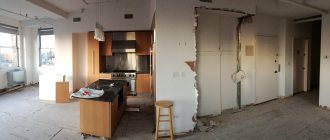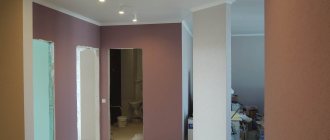Redevelopment of a private house is started if the space in the room is distributed irrationally and inconveniently. This can be fixed in two ways:
- add new premises
- completely change the interior layout
Homeowners, unlike apartment residents, do not have neighbors who may have a claim due to the demolition of a wall or the removal of a bathtub. But redevelopment of a residential building must be legal. All significant changes are approved by regulatory authorities - follow the link to read how to do this and what documents are required. This article tells:
- Which houses can be remodeled?
- How should the rooms in the house be located?
- Home remodeling projects
- A real example of a successful redevelopment of an old house
Project documentation: project or sketch
Redevelopment of a private house, like an apartment, regardless of whether it is carried out by the owner or with the involvement of specialists, should begin with the careful development of design documentation, which takes into account all the nuances of the proposed changes. The importance of creating a project is beyond doubt, especially if you plan to have at least some impact on floor slabs or load-bearing structures. It is worth remembering that rearranging the walls may result in partial or complete destruction of the building structure. Project documentation must be prepared in the following cases:
• changes in supporting structures;
• installation of stairs;
• installation of new equipment;
• when installing external glazing and major façade works.
You should entrust the preparation of the project only to professional design organizations that have SRO certificates, otherwise problems with approval may subsequently arise.
If during redevelopment the load-bearing structures are not affected, and no load is expected on the floor slabs, regulatory authorities can “give the go-ahead” for redevelopment only on the basis of a sketch.
Do I need permission?
The layout of a country individual residential building does not always suit its owner. It is possible that the housing was already purchased in this condition, but there is a possibility that during construction one arrangement of premises was assumed, and after several years of living there was a need to change something. In any such situation, prior approval of future work from regulatory government agencies is required.
Alternatively, you can do everything first and only then legitimize it. The owners are interested in whether it is possible to carry out renovations and redevelopment without permission, because the house actually belongs to the owner and no one’s interests are affected (the building is located separately). Formally, yes, such owners are right; the interests of surrounding neighbors are not affected. On the other hand, the owner is not always an expert and can determine whether certain work will be safe or not.
Example: During the renovation process, the owner decided to demolish one wall in order to combine two rooms and make one large hall out of them. If such a wall is load-bearing, then the house will simply collapse. At best, only the property will suffer, and at worst, the residents of such a dangerous building.
Thus, it is necessary to legitimize or approve redevelopment inside the house. As well as the construction of extensions. Without permission, you can only carry out minor repairs (also called cosmetic) or minor reconstruction in terms of changing the location of the batteries, moving the boiler, and so on. Otherwise, the structural integrity of the building may be compromised and this will become a threat to all residents of the house.
Redevelopment, redevelopment or reconstruction: is there a difference?
There is, although most often it is not very obvious. Redevelopment of an old wooden house or a newly built building is a rather complex procedure, which, as a rule, includes all three of the listed elements.
For example, reconstruction usually means small changes that do not require legalization. This could be moving the boiler to another location, changing the role of the room (make an office instead of a hall or vice versa), and so on. Simply put, these are any minor works that do not affect walls, floors, ceilings, communications and other similar elements.
Redevelopment is, in fact, a change in the configuration of premises inside a building without changing its external part and total area.
Example: Combining two rooms into one or dividing one room into two, increasing the area of one room at the expense of another, and so on.
Reconstruction is a more in-depth redevelopment. Most often, reconstruction involves changing the exterior of the house, adding extensions (or demolishing them), and so on. To simplify, reconstruction almost always affects the total area of the house.
Redevelopment and reconstruction need to be legalized. This is a mandatory requirement in order to make changes to the registration certificate. Even if we do not take into account the potential danger of work carried out without permission and without a well-designed project, other problems always remain.
For example, if the registration certificate does not correspond to how the house actually looks, it will be almost impossible to sell it and pledge it as collateral for a loan. The bank simply will not consider such real estate.
What needs to be legalized?
An approximate list of changes that must be legalized:
- Changes in the location of main communications or their installation (electricity, water, gas, etc.).
- Making changes to the location of bathrooms and restrooms (including moving them to another part of the house or creating new similar rooms).
- Changing the ventilation configuration or any other work related to this area.
- Changing the area of rooms, including the formation of new doorways, demolition/construction of walls and their relocation.
- Construction of a new building to replace an old building.
- Adding additional premises to the house/dacha.
Depending on the region of residence, other/additional rules and conditions for approval/legalization of redevelopment in a village house may apply.
What cannot be legitimized
Since a non-specialist most likely will not be able to carry out all the work correctly, you need to take into account the fact that in any case it will not be possible to legitimize:
- Any construction or renovation work that will affect the interests of neighbors.
- Construction of a balcony at the level of the 3rd floor and above, provided that this was not provided for in the original design of the house.
- Increased load on the main (load-bearing) walls of the house. Thus, it is almost impossible to turn a two-story house into a three-story one (an exception is possible only if the structure was originally designed for this, but for some reason the next floor was not built in a timely manner).
- Creation of living spaces inside the house without window openings.
- Violation of the ventilation configuration so that it becomes useless.
- Carrying out any work that could affect the structural integrity of the house (for example, demolition of load-bearing walls).
It is necessary to take into account the fact that if such work has already been carried out, most likely it will not be possible to solve the problem even through the courts. As a result, you will have to make regular repairs and correct any identified violations.
What is needed to obtain permission for redevelopment in a private house
The procedure for approving the redevelopment of a private house is identical to the process associated with legitimizing radical changes in the arrangement of housing in apartment buildings. This is not surprising, since many provisions of the Housing Code, which regulates the rules of redevelopment, are aimed at all types of residential buildings.
To obtain a permit that will make the redevelopment legitimate, you must submit an application to the local administration, to which a technical plan of the premises should be attached. In addition, an extract from the house register is required, as well as a certificate that confirms the legal right to use the property. Well, and, in fact, you will need the project itself.
By the way, written consent to the redevelopment must be given by each of the co-owners of the real estate.
Permissions from public utilities and sanitary authorities are also required, as well as the results of an expert assessment, which should indicate the house’s compliance with existing building standards. In some cases, inspectors may also require documents confirming the ownership of the land on which the house is located, which means you need to take care of their availability. You will also have to take and attach to the application detailed photographs of the external parts of the house, as well as photos of the interior.
The regulatory authority must provide official confirmation that all building regulations are observed during the redevelopment and that as a result of the changes, the housing will be suitable for further safe use. Local authorities, according to the law, have thirty working days to make a decision, and approximately this period should be calculated when preparing for work.
Sanctions for illegal redevelopment
Yes, unauthorized manipulations with changes in the “insides” of even one’s own private home can be punishable financially. In the form of a fine, for example. Illegal modifications without permission are usually discovered during the sale or purchase of property or its inheritance. Or, suddenly some regulatory authorities appear with an inspection. And when they discover illegally carried out redevelopment, they have the right to sue the owner of such an object.
And the unlucky owner will have to pay quite a fine. He may also be required to return all alterations to their previous state within a reasonable time.
In what cases can you expect a refusal of permission?
There is also a possibility of refusal; the reasons for a negative decision must be set out in detail in the document, which is the official response to the application for permission. Most often, regulatory organizations do not give permission for redevelopment if:
• in the new version of home improvement, there will be a risk of fire hazard, the technical and sanitary characteristics of the building will deteriorate;
• the consequence of redevelopment will be the weakening of load-bearing walls;
• reconstruction of heated loggias is planned;
• there is a high risk of a reduction in the service of the house or the building will become uninhabitable altogether.
Reasons for refusal may be an incomplete package of documents, lack of an expert opinion, or a poorly drafted project. There is a chance of obtaining approval after adjusting the project taking into account the stated reasons for refusal. Actually, if you disagree with such a decision of the authorities, you can file a lawsuit in court, but you need to take into account that in the event of an unfavorable outcome of the event, all legal costs are borne by the plaintiff.
How to legitimize?
The procedure for legalizing redevelopment is quite complex in itself. Moreover, in many cases it is simply impossible to do without the help of a competent lawyer. Especially if you have to defend your interests in court. The design procedure presented below is general. Depending on the region of residence and other features, other actions may be added or their order may change.
Procedure
- Prepare a redevelopment project for a country house/private house. This is a very important stage. Even if the work has long been completed and you just need to legalize everything that has been done, the project is still needed. Moreover, already at the stage of its preparation, specialists who will deal with this issue can immediately state which aspects cannot be legitimized under any conditions, and which ones they may well be able to legitimize. The project is like a reflection of what has been done. It will be compared with what is indicated in the data sheet to identify any changes made.
- Collect all other necessary documents (see list below).
- Select an MFC branch (My Documents) and visit it.
- Fill out an application for legalization of redevelopment.
- Submit such application and all collected documents to the MFC specialist.
- Wait for the decision and get it.
- With a positive decision, go to Rosreestr and make changes to the registration certificate. Go to court with a negative decision.
Documentation
To approve/legalize the redevelopment, the following documents will be needed:
- Redevelopment project . In rare cases, if minor changes have been made, it can be done independently, with minimal skills and knowledge. Most often, you need the help of specialists. It should be noted that the project can be both relatively small and very voluminous. It all depends on what exactly was done. So, for example, if you need to build an additional partition, then in addition to the fact that such a partition is displayed on the plan, you will need an additional sheet describing the structure of such a partition and another one with a calculation of the pressure of the partition on the floor.
- Applicant's passport . The document must be valid. It should not contain extraneous marks, it must include a photograph according to age, and so on.
- Passports or birth certificates of all co-owners . In this case, certificates are provided only if the homeowner does not yet have a passport (minor).
- Consent of co-owners to carry out redevelopment . This document is certified by a notary. Usually, separate consent is required from each co-owner, but much depends on the region where the property is located. Some MFCs may also accept “collective” consent.
- Power of attorney for the representative and his passport . This paragraph is relevant only if the applicant plans to act through a representative.
- Certificate of ownership . At the time of writing this article, an extract from the Unified State Register serves as such evidence. It is recommended to order such an extract immediately before submitting documents in order to provide the most “up-to-date” version.
- Registration certificate for the house . It is necessary so that those in charge can see how the final version of the layout differs from what it was.
- Title documents . This is usually a purchase and sale agreement, but other options are possible. For example, a gift agreement, a will, and so on.
In addition to all of the above, you will also need papers from various inspection structures, such as Fire Protection, Rospotrebnadzor, and so on. The applicant is not required to collect them all himself. The MFC specialist will request all the necessary papers.
Expenses
Coordination/legalization of redevelopment is a free procedure. You will only have to pay during the process of collecting documents:
- Redevelopment project: from 10 thousand rubles.
- Extract from the Unified State Register of Real Estate: 300 rubles.
- Consent of co-owners: from 1 thousand rubles each.
- Power of attorney for a representative: from 2 thousand rubles.
During the registration process, additional costs may be required if, for example, some documents (for example, a purchase and sale agreement) have to be restored. In addition, if the applicant receives a refusal and goes to court, he will also need to pay a state fee. Its size is 300 rubles.
Deadlines
On average, the entire approval/legitimation procedure, excluding court proceedings, can take about 2-3 months. Of them:
- Registration of a redevelopment project: from 1 week.
- Preparation of documents: up to 3-5 days.
- Waiting for a decision from the MFC: up to 45 days.
- Re-registration of a technical passport: from 3 days.
If you go to court, you can safely increase the period by about 3 months. Of these, the case will be considered for 2 months and another 1 month will have to wait until the decision comes into force.
What to do if legalization is denied
Often the owner makes changes to the house that cannot be legitimized in the general order. As a result, he is rejected by the MFC (My Documents). In this situation, the only way out may be to go to court, but one should take into account the fact that the court does not always side with the home owner. In practice, just the opposite is true, but you still need to try.
Very often, the decision greatly depends on the legal support of the homeowner. Qualified lawyers help both at the stage of applying to the MFC and when considering the problem in court. At a free consultation, our specialists will talk about the main features of this procedure and important points. They can also act as representatives of the client, achieving the desired result.
FREE CONSULTATIONS are available for you! If you want to solve exactly your problem, then
:
- describe your situation to a lawyer in an online chat;
- write a question in the form below;
- call Moscow and Moscow region
- call St. Petersburg and region
Save or share the link on social networks
(
1 ratings, average: 5.00 out of 5)
Author of the article
Natalya Fomicheva
Website expert lawyer. 10 years of experience. Inheritance matters. Family disputes. Housing and land law.
Ask a question Author's rating
Articles written
513
- FREE for a lawyer!
Write your question, our lawyer will prepare an answer for FREE and call you back in 5 minutes.
By submitting data you agree to the Consent to PD processing, PD Processing Policy and User Agreement
Useful information on the topic
Documents for redevelopment of an apartment in the MFC
Often the basic layout of an apartment does not meet the requirements or design of it...
2
Is it possible to legalize redevelopment after renovation?
It is recommended to coordinate the redevelopment of the apartment before starting work, however...
Liability and fine for redevelopment of an apartment or non-residential premises without permission
Uncoordinated (illegal or unauthorized) redevelopment of residential or non-residential premises may...
Redevelopment of an apartment in a panel house
A significant part of the Russian population lives in multi-apartment panel buildings, standard…
How much does it cost to legalize redevelopment in an apartment?
Remodeling an apartment is a costly undertaking. But in this case...
Coordination of redevelopment of non-residential premises
Coordination and legalization of the redevelopment of non-residential premises is in many ways similar to...
Internal changes requiring approval
Changes in the internal space of a private home, requiring mandatory approvals, are defined both in the Housing Code and in other regulations at the federal and local level. The most common conversions are the following:
• reconstruction of living quarters and, in particular, division of rooms;
• creation of new window and door openings;
• moving to a new kitchen location;
• installation of stairs;
• changing the location and configuration of the bathroom.
There is more space for permitted internal changes in a private home than in an apartment building, where, for example, it is impossible to move the kitchen or expand the sanitary unit at your own discretion. However, every action must be verified, planned and coordinated
, and as an example, here are some nuances that are worth paying attention to:
- Very often, when doing independent redevelopment, it is not taken into account that new premises cannot be left unheated
, which is not so easy to achieve in houses without central heating, but if this is allowed, difficulties may arise in legitimizing such a conversion.
- If you need to create a walk-through room
, you will need to first remove the partitions and make new window openings. If the partition is part of a window structure, it is necessary to install a steel beam onto which the main load will be distributed. It is also important to take care of installing special jumpers over the new door and window openings.
- If one room is divided into two by a new partition with a doorway
, it is necessary that the documentation reflects exactly how this will be done. Without problems and unnecessary questions, documents are approved where it is planned to create a plasterboard wall on a metal or wooden frame, if the wall does not exert a serious load on the foundation elements.
However, options for interior work can be very different, and in some cases approval is not required. Without any permits or approvals, you can carry out any cosmetic repairs, change doors and windows, and perform additional work on the floor and ceiling. In any case, complex work performed without permission will have to be legalized.
When permission for redevelopment is not required
There is no need to submit a project and obtain permission in the following cases:
- installation of built-in furniture;
- carrying out cosmetic repairs (coating the floor and ceiling, laying tiles, replacing wallpaper on the walls), which does not require a significant change in the design of the living space;
- glazing of balconies and loggias, installation of antennas;
- when installing partitions in an apartment that do not affect the supporting structures;
- rearrangement (installation of a new) electric stove within the kitchen;
- installing an air conditioner on the wall of the facade of the house.
Is it even necessary to arrange redevelopment in a private house?
You can, of course, live with illegal redevelopment, but only until the time comes for a change of owner or other real estate transactions are required (donation, mortgaging, inheritance, etc.)
. For example, when selling or buying a home, the compliance of buildings with the technical plan must be checked.
Quite often there are situations where people live in a rebuilt house for many years, without even suspecting that they have broken the law. But then the time comes to check the documents, and they are faced with the need to pay a significant fine, or even completely return the building to its original state. In such cases, litigation cannot always be avoided.
Legislative regulation
The main laws that regulate the redevelopment of a private house are:
- Articles 25 to 29 of the Housing Code of the Russian Federation , which regulates legal and illegal actions for redevelopment and reconstruction of the interior of a house;
- Government Decree No. 266 of the Russian Federation contains the form of the document and application for redevelopment and regulates the coordination of work with administrative authorities;
- Article 7.12 of the Code of Administrative Offenses dictates the responsibility of the owner who decides to carry out redevelopment without permission from the authorities.
- In addition, at the regional level there may be additional legislation regulating such actions in residential premises.
How to legalize the redevelopment of a private house in court
Despite repeated warnings about the mandatory registration of redevelopment, many owners of private houses still carry out work without permits and even without any sketches, and the problem with legalization arises when trying to carry out any transaction with housing. It should be noted that every year it becomes more and more difficult to arrange redevelopment “retroactively”.
The Housing Code (Article 29) provides for the possibility of legalizing the work carried out in court. This procedure will be relatively painless if the redevelopment is carried out without violating the standards, with the consent of all co-owners of the house and in compliance with the interests of the neighbors.
When preparing to legalize redevelopment in court, you should pay very close attention to the preparation of documents, not missing out on the nuances, and also prepare money not only to pay off current costs, but also to pay fines if the changes were carried out with violations. If all the rules are followed and the court makes a positive decision, this decision is the basis for the redevelopment to be legalized at all levels.
Why register?
Many people wonder why such actions need to be formalized at all, since the person is the owner and can independently make decisions regarding his property? The thing is that not all operations of this nature are safe. It is possible that during dismantling the supporting structures may be damaged, which can be dangerous.
Read about the consequences of illegal redevelopment here.
Without registering the redevelopment in accordance with the law, you risk encountering problems when selling real estate, since all actions of this kind must be registered in the cadastral documents of the structure . The technical passport of the object must be updated upon sale, which obliges the owner to invite an inspector who, having identified a discrepancy with the plan, can impose a fine on the owner and force him to restore everything according to the plan in court.
Attention!
Therefore, the most correct decision would be to register the changes and make them according to the law. The cost of registration will be 2,500 rubles, and the period within which the permit will be ready will be 2 months.
Going to court: procedure
The first step is to personally contact the local housing organization and submit an application indicating that the house has been remodeled without permission. Next, you should prepare a statement of claim to the court and go to the territorial technical inventory office to obtain documents where the layout of the house is spelled out in all details. A project is required that reflects the current configuration of the premises or the condition of the building structures.
If the court makes a positive decision, the next step will be the preparation of new cadastral documentation and registration of the property. Then a package of documents, including a court decision, is submitted to the Rosreestr office, and after making changes to the official database, the layout is legalized.
Unauthorized redevelopment: what you need to know
Any construction and repair work not approved by the municipal authority, which entails a change in the configuration of the residential premises, is an unauthorized redevelopment.
Consequences of unauthorized redevelopment
Changing the configuration of housing without the permission of the municipal authority is an administrative offense, liability for which is provided for in Articles 7.21–7.22 of the Code of Administrative Offenses of the Russian Federation.
A change in the condition of a residential building entails a fine on its owner in the amount of 1,000 rubles. up to 1,500 rub.
Carrying out repair and construction work on the reconstruction of housing or its major repairs without the appropriate permission from the local government in apartment buildings, the amount of penalties will be from 2,000 rubles. up to 2,500 rub.
In case of changes in the conditions of use of housing for its intended purpose in connection with redevelopment carried out by responsible persons, the fine amount will be from 4,000 rubles. up to 5,000 rub. for officials, from 40,000 rubles. up to 50,000 rub. on organizations (Article 7.22 of the Code of Administrative Offenses of the Russian Federation).
Legalization of unauthorized redevelopment
After redevelopment work has been carried out without the consent of the district administration or repairs have been carried out not in accordance with the measures stated in the project, it is possible to legitimize the changes made to the residential premises through the court (in accordance with Part 4 of Article 29 of the Housing Code of the Russian Federation).
Before going to court, you must collect the following documents:
- a certificate of the technical condition of the housing (with a description of the changes and the condition of the housing before and after repairs);
- conclusion of the design company (confirmation of compliance of the repair with safety requirements, technical and construction standards);
- conclusion of the hygiene and epidemiology institution (confirmation of compliance with sanitary standards and requirements);
- technical passport of the residential premises.
Bathroom remodeling
Bathroom remodeling is carried out at the very initial stage of renovation. Previously, it was used to combine a bathroom with a bathroom, but now this trend is safely disappearing, and today the main goal of such redevelopment is to increase the area (the increase can be 1 sq. m or more). This redevelopment has its advantages: the erected partitions will be strictly vertical and thicker than their predecessors; moreover, after removing the bottom plate of the plumbing cabin in the bathroom, it will be possible to install two-meter standard doors.
Terminology
Reconstruction
– this is a change in the technical characteristics of a building without making adjustments to its layout. Reconstruction is considered to be a major overhaul of the facade or a change in the appearance of the building, glazing of loggias, improvement of door or window openings, and so on.
Reconstruction may consist of the following types of work:
- replacement of utility networks or changes in their location;
- construction of extensions;
- construction of a new balcony or loggia, or glazing of existing ones;
- restoration or complete change of façade finishing;
- restoration of load-bearing structures;
- arrangement of new entrances or vestibules;
- dismantling old parts of the facade and installing new ones;
- changing the number of floors of a room, for example by adding a mezzanine.
These works can be carried out either in combination or separately. Load-bearing structures and exterior decoration are only partially changed during the reconstruction process.
Redevelopment
is a change in the size and configuration of a building and its functionality. The work concerns the interior of the buildings and does not affect the facade, with the exception of window openings.
The key goal of the redevelopment is to improve the quality of the premises so that after the renovation they can be used more comfortably and efficiently.
During redevelopment the following work is carried out:
- demolition of old and construction of new partitions;
- changing the position and size of window and door openings;
- dismantling old walls, changing their position or building new ones.
Redevelopment is one of the parts of reconstruction, which includes a larger number of works, being a more multifaceted concept compared to redevelopment.
Prohibited redevelopment options
This list includes things that definitely cannot be agreed upon.
Expansion of the kitchen at the expense of the living room . Rooms cannot be combined if a gas stove is installed. The partitions should remain, but if you get creative, you can make them sliding or arrange a wide arched opening.
The location of the bathroom is above the living space or kitchen . The ban does not apply to apartments on the ground floor, as well as to those below which there are only non-residential premises.
Installation of heating radiators on a balcony/loggia . The rooms and kitchen are warm, the balcony is cold. Removing the barrier between them violates the integrity of the thermal circuit of the entire building. The ban applies only to the removal of radiators installed in the apartment.
Increasing the area of the bathroom due to the living space or kitchen . The non-residential area of the apartment cannot be increased at the expense of the residential area. Also, you cannot place the bathroom above your neighbors’ kitchen.
Hiding risers for heating, gas and water supply, and sewerage in the walls . This makes them difficult to access in case of emergency.
Installation of a solid fuel fireplace . The ban does not apply to biofireplaces and electric fireplaces. Conventional fireplaces in apartment buildings can only be installed by residents of the top floors.
Any redevelopment affecting crossbars, pylons, columns and other load-bearing elements of the building . Violation of these structures threatens the integrity of the house.








